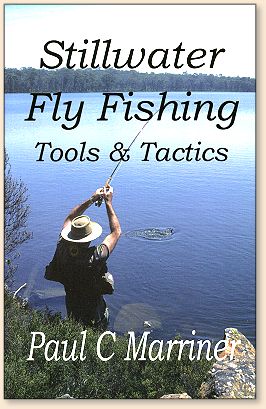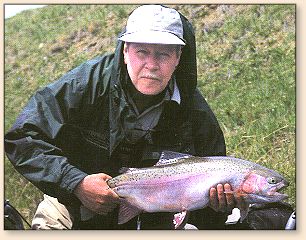|
According to Webster, limnology is the
science of the biological and other
phenomena of fresh water, especially of
ponds and lakes. Assuming a healthy
population of fish, much of this body of
knowledge has no direct application to
fly-fishing success. However some has,
and besides we need to establish a glossary
of terms used elsewhere. One general comment
concerns the word lake itself: in Scotland
it's a loch, in Wales a lynn, and in Ireland
a lough. I use these names where appropriate.
WHAT IS A STILL WATER?
 In general, stillwaters include lakes and
ponds. A stillwater is called a lake when
it's large enough to have waves that create
a wave-swept zone, otherwise it's a pond.
Newfoundlanders, going their own way as
they often do, call many of their island
lakes ponds.
In general, stillwaters include lakes and
ponds. A stillwater is called a lake when
it's large enough to have waves that create
a wave-swept zone, otherwise it's a pond.
Newfoundlanders, going their own way as
they often do, call many of their island
lakes ponds.
LAKE CLASSIFICATION
One lake classification with which many
readers will be familiar is trophic status.
Lakes are oligotrophic, mesotrophic, or
eutrophic, depending on nutrient level.
However, when considering very large lakes,
like the Great Lakes, various regions of
such lakes may fall into different
classifications. Water clarity is an
indication of trophic status.
Oligotrophic
Oligotrophic lakes have low nutrient levels,
are often cold and deep, and feature close
to 100% oxygen saturation. The characteristic
clear water results from the lack of nutrients.
Many northern glacial lakes are oligotrophic,
including some which are also quite shallow.
Cold temperatures and high oxygen content
mean that they often support salmonid
populations. Exceptions include those killed
by acid precipitation. Trout do not flourish
in stillwaters with a pH below 5.0.
Eutrophic
Eutrophic lakes have high nutrient levels,
are usually shallow and warm, and generally
suffer from low oxygen content particularly
in the deepest parts. High nutrient levels
create cloudy water. For example, many
man-made ponds at low altitudes fit into
this category and will normally support
only species like carp that tolerate low
oxygen levels.
Mesotrophic
It's likely that most of the world's lakes
are mesotrophic, meaning that they are
moderately enriched and not very deep, and
can support a variety offish species.
While these are the generally accepted definitions
and characteristics, trout anglers will know
that they don't always apply. Some of our
best trout fisheries are eutrophic lakes
with cold water sources or ones that are
located at a high enough altitude to stay
cool. Within this group are stillwaters
that need oxygen supplied artificially.
Of these, some need oxygen to prevent
winterkill, while others need it in summer
as well. Many of these eutrophic lakes are
so rich that they suffer mightily from algae
blooms during the hottest months.
GEOLOGICAL CLASSIFICATION
Another way to deal with lakes relates to
their origin, with one text in my library
listing twenty-eight types; interesting stuff
but of little practical use. One exception is
when knowing how a stillwater was formed leads
to searching out specific fish-holding structure
like an old river bed in an impoundment. One
estimate suggests that more than two-thirds
of all lakes in the northern latitudes are
glacial in origin, but as the local geography
usually determines their trophic status such
a description is of little help. Some types
of stillwaters referred to later may be
unfamiliar and so their descriptions follow.
(Precambrian) Shield Lakes
The Precambrian Shield is a vast horseshoe-shaped
area around Hudson Bay covering eastern and
central Canada, and a small part of the
northern United States. The rocks contain
large areas of granite and the lakes gouged
out of the shield by glaciation are numerous,
often long and narrow, and oriented in the
direction of the glacier's retreat. Many of
these lakes are oligotrophic and support
salmonids. Kettle lakes are another glacial
remnant. They were formed when large blocks
of glacial ice melted into relatively shallow
spring-fed depressions. Because the surrounding
glacial debris (moraine) is often rich in pH
boosting minerals, these lakes support abundant
fish populations. They are found scattered
throughout the shield, including easily
accessible areas in central Canada and across
the northern tier of adjacent US states. In
other parts of the world these lakes are
sometimes called tarns. Tens of thousands
of kettle lakes are found in the far north
but they are of little interest to fly-fishers.
Bogan
A bogan is a stillwater formed by a
cold-water stream in the interval (or flood
plain) of a large river or an inlet stream
removed from the general shoreline of a lake.
The size is variable depending on the distance
between the stream mouth and the main river
or lake, but all those I have encountered
would be considered ponds. When associated
with rivers, water from the bogan usually
enters the main river over a shallow bar.
In summer, bogans are generally colder than
the main river or lake, and often offer
shelter to trout.
Although not called bogans, a similar coastal
phenomenon produces small freshwater ponds,
often behind beaches. Like bogans the inlets
and outlets are generally small, however if
the pond is large enough it may support a
resident trout population (some are stocked)
or be visited by anadromous species.
Pothole Lakes
 One area where anglers cross swords with
scientists is in the definition of pothole
lake. The limnologists consider these to
be lakes created by fluvial (i.e., river)
forces. However, when most of us speak of
pothole lakes, we mean small ponds, usually
on the prairies, created naturally (much
like kettle lakes but rarely as deep) or
artificially in local depressions and
supplied by springs. What the scientists
refer to as a pothole I generally call a
river stillwater.
One area where anglers cross swords with
scientists is in the definition of pothole
lake. The limnologists consider these to
be lakes created by fluvial (i.e., river)
forces. However, when most of us speak of
pothole lakes, we mean small ponds, usually
on the prairies, created naturally (much
like kettle lakes but rarely as deep) or
artificially in local depressions and
supplied by springs. What the scientists
refer to as a pothole I generally call a
river stillwater.
Tarn
Tarn is defined in the dictionary as a high
mountain lake. However, at least in my
experience, the word is also often used
to describe a medium-sized, shallow,
high-plateau lake, usually mesotrophic.
In most ways they resemble a prairie
pothole, just larger and higher in
elevation. ~ PCM
More next time on Limnology.
Credits: Excerpt from Stillwater Fly Fishing,
Tools & Tactics By Paul C. Marriner, published
by Gale's End Press. We appreciate use
permission.
|



